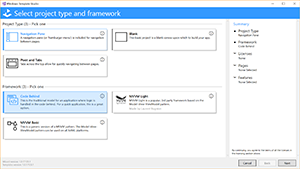News
Microsoft Killing Windows App Studio Low-Code Tool, Offers Open Source Replacement
- By David Ramel
- July 5, 2017
Microsoft is shutting down its free, online, wizard-based tool for creating Universal Windows Apps (UWA) in favor of an open source replacement.
After a four-year run, Windows App Studio will shut down Dec. 1, after which the new Windows Template Studio open source project -- hosted on GitHub -- will continue with an improved code generation engine and workflow wizard.
"Windows Template Studio is a Visual Studio 2017 Extension that accelerates the creation of new Universal Windows Platform (UWP) apps using a wizard-based experience," the GitHub site says. "The resulting UWP project is well-formed, readable code that incorporates the latest Windows 10 features while implementing proven patterns and best practices. Sprinkled throughout the generated code we have links Docs, Stack Overflow and blogs to provide useful insights."
With its tight integration with the Visual Studio IDE, Windows App Studio (previously called Windows Phone App Studio), let Windows developers create phone or other apps that could be published to the Windows Store. While relying upon a GUI-based, wizard-driven development experience that typically was used for Web apps and simple content-streaming apps, users could easily transition Windows App Studio projects to Visual Studio for more advanced programming or code compilation and submission to the Windows Dev Center.
Windows App Studio featured wizards for creating logos and images, for example, and easily tied into social media sites such as YouTube, Flickr and Facebook to display their content aided by customizable theme templates.
 [Click on image for larger view.]
Windows Template Studio (source: Microsoft)
[Click on image for larger view.]
Windows Template Studio (source: Microsoft)
As the name suggests, the new Windows Template Studio will continue the reliance upon templates, as revealed by its founding principles:
- Generated templates will be kept simple.
- Generated templates are a starting point, not a completed application.
- Generated templates once generated, must be able to be compiled and run.
- Generated templates should work on all device families.
- Templates should have comments to aid developers. This includes links to signup pages for keys, MSDN, blogs and how-to's. All guidance provided should be validated from either the framework/SDK/library's creator.
- All features will be supported for two current Windows SDK for Windows 10 release cycles or until another principle supersedes it.
- Templates released in production will try to adhere to the design language used in the current release of Windows 10.
- Code should follow .NET Core coding style.
The new tool provides a choice of project types, including basic, navigation pane, and pivot and tabs, and frameworks, such as code behind, basic MVVM and MVVM Light. After those choices are made, developers can choose to add a number of template-based "app pages," for common layouts such as master/detail, tabbed and web view. Furthermore, developers can choose what Windows 10 features to implement.
"You specify which UWP capabilities you want to use in your app, and we'll build out the framework for the features into your app, tagging 'TODO' items," the project's GitHub site says. "Currently supported features cover application lifecycle (settings storage, suspend and resume), background tasks, and user interaction (app notifications, Live tiles, and Azure Notification Hub).
"Once you select the attributes you want your new UWP app to have, you can quickly extend the generated code."
According to the roadmap for Windows Template Studio, a version 1.2 release is set for this month, followed by a version 1.3 release next month. The first version 0.5 release debuted in April, and the project was formally introduced in May.
"Windows Template Studio is the evolution of Windows App Studio," Microsoft said in a blog post Friday. "We took our learnings from the code generation engine and the existing wizard to provide a strong foundation for our code generation and developer experience in Windows Template Studio. Best of all, it is open source over at http://aka.ms/wts.
The process for shutting down Windows App Studio includes a July 15 cut-off date for new users to sign in and other sunsetting measures. On Sept. 1, the application editor will stop working and API-provided data will not be available to existing apps, with total closure occurring Dec. 1.
About the Author
David Ramel is an editor and writer for Converge360.